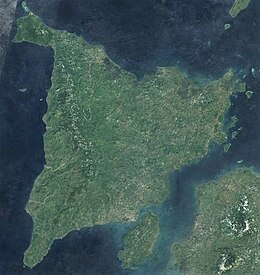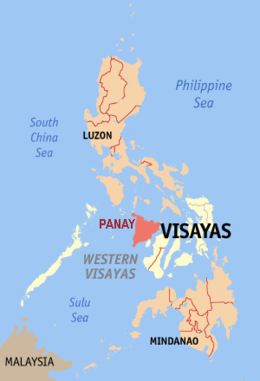
Back Panay Afrikaans باناي Arabic پاناى ARZ Panay AST Panay Azerbaijani Panay BCL Панай Byelorussian Панай Bulgarian Panay Breton Panay BS
 Panay island satellite image captured by Sentinel-2 in 2016 | |
 Location within the Philippines | |
| Geography | |
|---|---|
| Location | South East Asia |
| Coordinates | 11°09′N 122°29′E / 11.150°N 122.483°E |
| Archipelago | Visayas |
| Adjacent to | |
| Area | 12,011 km2 (4,637 sq mi)[1] |
| Area rank | 65th |
| Highest elevation | 2,117 m (6946 ft)[2] |
| Highest point | Mount Madja-as |
| Administration | |
Philippines | |
| Region | Western Visayas |
| Provinces | |
| Largest settlement | Iloilo City (pop. 457,626) |
| Demographics | |
| Demonym | Panayan/Panayanon |
| Population | 4,542,926 (2020)[3] |
| Pop. density | 358/km2 (927/sq mi) |
| Ethnic groups | |
Panay is the sixth-largest and fourth-most populous island in the Philippines, with a total land area of 12,011 km2 (4,637 sq mi) and a total population of 4,542,926, as of 2020 census.[4] Panay comprises 4.4 percent of the entire population of the country.[5] The City of Iloilo is its largest settlement with a total population of 457,626 inhabitants, as of 2020 census.
Panay is a triangular island, located in the western part of the Visayas. It is about 160 km (99 mi) across. It is divided into four provinces: Aklan, Antique, Capiz, and Iloilo, all in the Western Visayas Region. Just off the mid-southeastern coast lies the island-province of Guimaras. It is located southeast of the island of Mindoro and northwest of Negros across the Guimaras Strait. To the north and northeast is the Sibuyan Sea, Jintotolo Channel and the island-provinces of Romblon and Masbate; to the west and southwest is the Sulu Sea and the Palawan archipelago[6] and to the south is Panay Gulf. Panay is the only main island in the Visayas whose provinces don't bear the name of their island.
Panay is bisected by the Central Panay Mountain Range, its longest mountain chain. The island has many rivers, the longest being the Panay River at a length of 168 kilometres (104 mi), followed by the Jalaur, Aklan, Sibalom, Iloilo and Bugang rivers. Standing at about 2,117 m (6,946 ft), the dormant Mount Madja-as (situated in Culasi, Antique) is the highest point of the island,[2] with Mount Nangtud (located between Barbaza, Antique and Jamindan, Capiz) following next at 2,073 m (6,801 ft).
Historically, the terms Bisaya or Visayan were first used to refer only to the people of this island, the Panayan or Hiligaynon people, and to their other settlements on the nearby islands, in the western portion of Negros Island and the smaller islands of Romblon and Guimaras.[7] Panay also originally represented the entire Visayas region on the Philippine flag as one of the three stars, as it served as the center or mainland of the Visayas during the Philippine Revolution.[8]
The island lent its name to several United States Navy vessels including USS Panay (PR-5), sunk in 1937 by the Japanese in the USS Panay incident.
- ^ "Islands by Land Area". Island Directory Tables. United Nations Environment Programme. Retrieved June 7, 2021.
- ^ a b Cite error: The named reference
pnwas invoked but never defined (see the help page). - ^ Census of Population (2020). Table B - Population and Annual Growth Rates by Province, City, and Municipality - By Region. Philippine Statistics Authority. Retrieved 8 July 2021.
- ^ Census of Population (2015). Highlights of the Philippine Population 2015 Census of Population. Philippine Statistics Authority. Retrieved 20 June 2016.
- ^ Boquet, Yves (2017). The Philippine Archipelago. Springer Geography. Cham, Switzerland: Springer. p. 16. ISBN 978-3-319-51926-5.
- ^ Hogan, C. Michael (2011) [2009]. "Sulu Sea". Encyclopedia of Earth. Archived from the original on 2012-05-04.
- ^ Steiger, G. Nye; Beyer, H. Otley; Benitez, Conrado (1929). A History of the Orient. Oxford: Ginn and Company. pp. 122–123.
- ^ "NCCA-Symbolisms/Meanings in the Philippine Flag". National Commission for Culture and the Arts. Retrieved 2022-04-24.